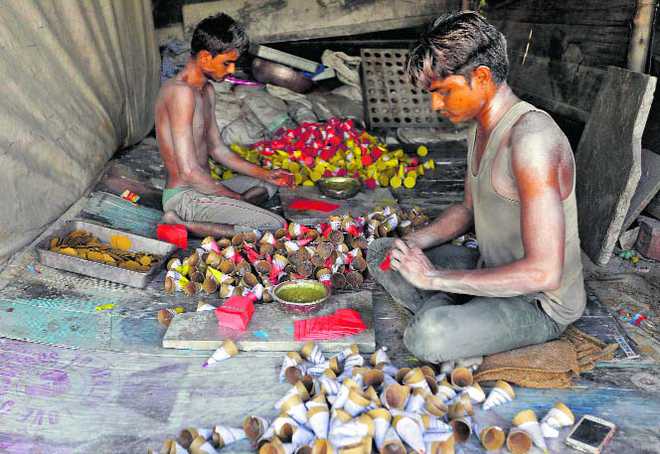
REUTERS
Suresh Dharur in Hyderabad
Safety is the last word in priorities for Sivakasi in Tamil Nadu, the firecracker hub of India. Virtually each household in the town serves as a cottage industry racing against time to meet the demand pouring in from across the country ahead of Diwali.
Sivakasi in Virudhunagar district, is considered the world’s second largest fireworks manufacturing center after Liuyang in China. It has over 700-odd factories, accounting for over 80% of India’s firecrackers. About 1.5 lakh people are engaged in the hazardous activity. The accidents are an annual ritual: the death toll becomes a mere statistics. Almost every Diwali season, the town witnesses a fire accident. The plight of workers, a major chunk of them child labourers, gets noticed only when there is a tragedy and then it is business as usual.
Between 2006 and 2012, there were as many as 84 fire accidents in the cracker factories, killing 185 people. In a blast that ripped through a factory in 1991, 39 people were killed and 65 others were injured. In July 2009, more than 40 people died. In August 2011, seven people were killed and five were seriously injured. A similar fire accident in September 2012 had claimed 40 lives. On October 20 this year, nine people were killed when a fire broke out while crackers were being offloaded from a vehicle to a cracker shop.
A visit to the firecracker factories and the storage units in the town provides a clue to the dangerous work. In a majority of the units, one finds child labourers engaged in the hazardous work without even a semblance of safety measures. The economy of Sivakasi is largely dependent on firecrackers and match manufacturing as the hot and dry climate of the town is conducive to these industries.
The common reasons cited for the frequent accidents are inadequate training of workers and supervisors involved in different stages of production, packaging and transporting of firecrackers. “Lack of technical training in handling chemicals is a major cause of tragedies. Most workers have no idea about what chemicals they are mixing. Even the basic safety precautions such as using rubber mats and gloves are absent,” says a social activist Ramaswamy.
According to the Petroleum and Explosives Safety Organisation, a government institute that monitors the industry, at least 25 workers die in accidents, a majority of them in the fireworks units of Sivakasi. Most of the fireworks units in the industry employ temporary workers who are made to work in overcrowded places which expose them to high risk. The installation of fire extinguishers in the firecracker units is mandatory but this rule is observed more in breach than in practice. Poor safety standards and low wages to workers go virtually unpunished.
An estimated 50,000 children are employed in these units. Sections 35 and 36 of the Factories Act provide that in fireworks factories, no electric wiring should be present, and wooden slippers should be provided to prevent sparks that might ignite the sulphur chemicals. Asbestos overcoats and other safety items should be provided.
However, in Sivakasi, the small fireworks units are not registered under the Factories Act. The employers do not maintain records nor do they provide safety measures. Even those factories registered under the Factories Act violate its provisions with impunity.
The gunpowder and other chemicals are spread on the floor and the workers are seen handling them without wearing masks or gloves. These chemicals affect the lungs leading to serious respiratory diseases, warn medical experts.
The NGOs working in the area point out that the factories routinely flout safety norms, endangering hundreds of lives. The industry is also notorious for employing inexperienced child workers, increasing the risk of accidents.
According to a study published in the International Journal of Environmental Engineering and Management in 2013, the explosions caused by faulty handling of dangerous raw materials are by far the most common hazard.
Experts have suggested automation of the fireworks industry can go a long way in checking accidents. Now, machines are available in the market to mix chemicals. By installing these machines, the risk caused due to human error can be minimized, it is argued. Overcrowding of the workplaces is another cause of concern. Ahead of Diwali season, the factories are crammed with workers with virtually non-existent safety measures. According to a study published in the International Journal of Environmental Engineering, prolonged exposure to chemicals in these enclosed conditions could cause lead poisoning, ulcers and damage to the central nervous system.



























